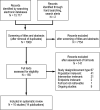Surgical and Non-Surgical Interventions in Complete Rotator Cuff Tears
- PMID: 33263527
- PMCID: PMC7817785
- DOI: 10.3238/arztebl.2020.0633
Surgical and Non-Surgical Interventions in Complete Rotator Cuff Tears
Abstract
Background: This systematic review compares the efficacy and safety of surgical and non-surgical interventions for full- thickness rotator cuff tears.
Methods: A systematic literature search was conducted in five databases. Randomized (RCTs) and non-randomized controlled trials of interventions (non-RCTs) for the surgical or non-surgical treatment of patients with traumatic or atraumatic full-thickness rotator cuff tears were included. The review protocol was published in the PROSPERO registry (CRD42018100343).
Results: Ten studies (three RCTs with 332 participants; seven non-RCTs with 650 participants) met the inclusion criteria. One year after treatment, shoulder function, measured with the 100-point Constant score, had improved by 6.7 points (95% confidence interval [2.3; 11.0]) and pain, measured with the 10-cm visual analog scale, by 1.1 cm (0.5; 1.7] in the full-thickness rotator cuff tears treated surgically compared with non-surgical treatment. In one study the difference in favor of surgery persisted after 10 years' follow-up. For other outcomes, such as range of motion, muscle strength, quality of life, and adverse events, the data were sparse and the group differences were similar. The findings of the non-RCTs were comparable with those of the RCTs.
Conclusion: With regard to functional improvement and pain reduction, surgical treatment of full-thickness rotator cuff tears was superior to non-surgical treatment in the short and the long term. Whether the differences between the groups are relevant for individual cases is uncertain, as the measured results were distributed below and above the threshold of clinical relevance. The conclusions may not be applicable to rotator cuff tears over 3 cm in size or to young persons.
Figures





References
-
- Yamamoto A, Takagishi K, Osawa T, et al. Prevalence and risk factors of a rotator cuff tear in the general population. J Shoulder Elbow Surg. 2010;19:116–120. - PubMed
-
- Piitulainen K, Ylilnen J, Kautiainen H, Häkkinen A. The relationship between functional disability and health-related quality of life in patients with rotator cuff tear. Disabil Rehabil. 2012;34:2071–2075. - PubMed
-
- Desmeules F, Braen C, Lamontagne M, Dionne CE, Roy JS. Determinants and predictors of absenteeism and return-to-work in workers with shoulder disorders. Work. 2016;55:101–113. - PubMed
Publication types
MeSH terms
LinkOut - more resources
Full Text Sources
Medical
Miscellaneous

